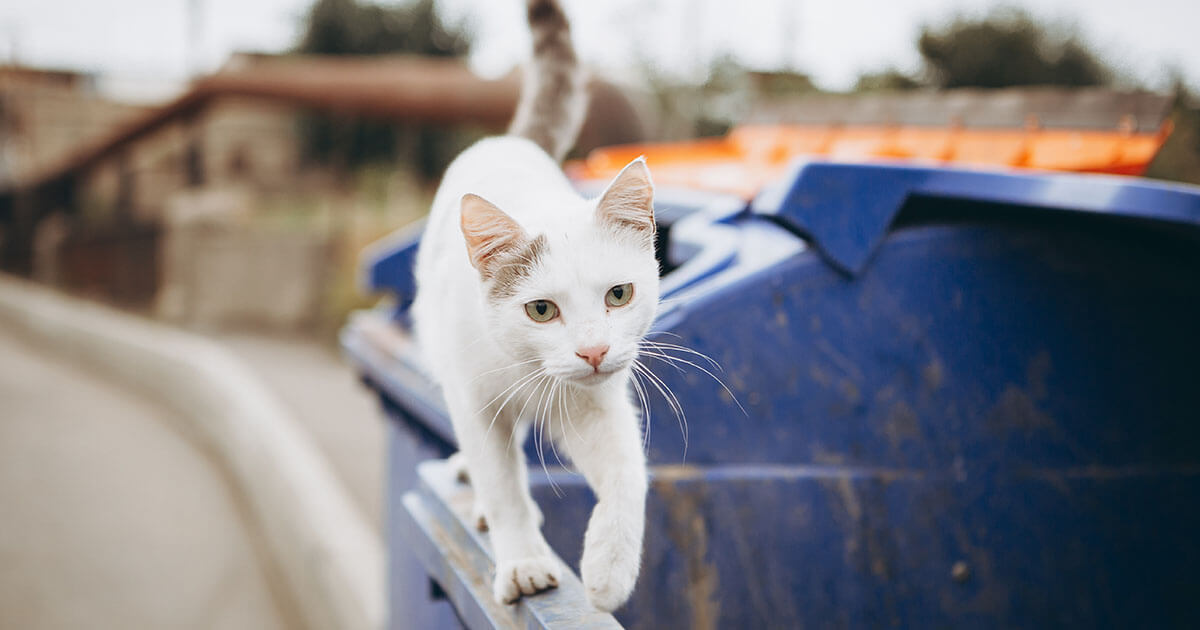To deter stray cats, employ deterrents such as motion-activated sprinklers and scented repellents. Secure your trash and avoid leaving out food that can attract them.
Dealing with stray cats in your garden or around your home can be a challenge, requiring a delicate balance between humane treatment and protecting your space. Maintaining a cat-free zone often starts with simple, non-harmful methods like setting up physical barriers or using natural deterrents.
These methods not only prevent cats from causing damage but also keep them safe. Homeowners are increasingly seeking effective ways to repel these feline visitors without resorting to extreme measures. As communities become more aware of the stray cat population, finding compassionate yet practical solutions has become essential. The effectiveness of such strategies can be enhanced through consistency and a good understanding of cat behavior, leading to a peaceful coexistence.
The Stray Cat Conundrum
The Stray Cat Conundrum stirs emotions in every neighborhood. While these feline wanderers may evoke sympathy, their growing presence cannot be ignored. Understanding the crux of this issue helps communities approach it effectively, ensuring humane and long-lasting solutions.
Why Stray Cats Are A Community Issue
Stray cats lead to several community concerns. They often form colonies, affecting local ecosystems. These cats can also bring noise, as their cries and fights disrupt neighborhood peace. Additionally, they may cause property damage, scratching cars, and leaving unwanted ‘gifts’ in gardens. Below highlights the gravity of the stray cat situation:
- Public Nuisance: Regular vocalisations and marking territory can be disruptive.
- Overpopulation: Unchecked breeding leads to more strays.
- Property Harm: Scratched vehicles and fouled yards upset residents.
Health And Environmental Impacts
Stray cats pose significant health and environmental risks. They can carry diseases such as rabies, toxoplasmosis, and feline leukemia, easily transmittable to other animals and humans. Their predation disrupts local fauna, endangering bird populations and other wildlife. Environmental implications demand urgent attention:
| Disease Transmission | Wildlife Threat | Ecosystem Imbalance |
|---|---|---|
| Rabies, FIV, and others spread to pets and people. | Cats prey on birds and small mammals, disturbing the fauna. | Preying on native species can lead to a biodiversity decline. |
Communities benefit from strategies addressing stray cat populations. Such methods focus on humane capture, neutering, and adoption. Education on responsible pet ownership also plays a vital role. Local collaboration can transform the stray cat conundrum into a managed community project, enhancing the environment for all.
:max_bytes(150000):strip_icc()/discourage-feral-cats-386479-hero-50eeb16535844e75853d52720baeaec5.jpg)
Credit: www.thespruce.com
Common Misconceptions About Strays
Common Misconceptions About Strays often form the basis of how communities deal with these animals. Stray cats, also known as ferals, frequently prompt debates on their care and control. It’s vital to clear up some of the widespread misunderstandings to ensure that strays are treated humanely and effectively.
Feeding Ferals: Kindness Or Hindrance?
Many believe giving food to feral cats is an act of kindness. Yet, consistent feeding can result in dependency, which may not be in the cats’ best interest. Additionally, increased food sources can lead to larger feral populations, as access to food supports reproduction.
- Feeding can attract more strays to an area, creating colonies.
- Not all food given is nutritionally adequate for a cat’s health.
- Feeding without a long-term care plan might cause more harm than good.
Myths About Cat Behavior And Repellents
The internet is rife with quick fixes to deter stray cats. Nonetheless, many so-called repellents are based on myths rather than facts. Understanding cat behavior is key to implementing any effective deterrent.
| Myth | Fact |
|---|---|
| Cats hate water | Some cats dislike it, but water rarely acts as a consistent repellent. |
| Mothballs keep cats away | Mothballs can be toxic to cats and are not a humane deterrent. |
| Ultrasonic devices deter cats | Effectiveness varies, and some cats may become accustomed to the noise. |
Research and understanding of stray cat behavior are essential. Implementing a humane approach benefits both cats and the community.
Humane Deterrence Principles
Stray cats can pose a challenge for homeowners. Humane deterrence principles guide us to discourage these feline visitors without causing harm. These methods respect the well-being of cats while protecting your space.
Ethical Ways To Discourage Feline Visitors
Ethical deterrence focuses on methods that are kind and effective. Here are some:
- Use natural repellents. Citrus peels or coffee grounds in your garden can keep cats away.
- Install motion-activated sprinklers. The surprise of water deters cats without injury.
- Secure trash bins. Closed lids prevent the allure of food scraps.
- Use olfactory deterrents like commercial cat repellents that emit smells cats dislike.
The Importance Of Neutering And Community Programs
Neutering is crucial in managing stray populations. Fewer strays mean fewer visits. Community programs play a role:
- Trap-Neuter-Return: Cats are trapped, neutered, and released to decrease populations.
- Education on responsible pet ownership reduces abandonment.
- Adoption initiatives promote finding homes for strays.
Engaging with local organizations can amplify your efforts. Reach out to animal shelters or welfare groups for resources and support.
Tried And Tested Deterrents
Stray cats can be a real challenge for property owners. Keeping them away doesn’t have to be a battle. Try these effective deterrents to maintain harmony in your yard.
Natural Repellents And Their Effectiveness
Natural options safeguard your yard with minimal impact on the environment.
- Citrus peels: Cats dislike the smell. Scatter orange or lemon peels around your garden.
- Coffee grounds: Mix them with soil. They’re eco-friendly and cat-repelling.
- Essential oils: Eucalyptus, lavender, and citronella oils deter cats. Dilute with water and spray around the yard.
- Cayenne pepper: Sprinkle around your garden. It’s a natural irritant to cats.
Each natural deterrent varies in effectiveness. Monitor your yard for results and adjust accordingly.
Commercial Solutions For Cat-proofing Your Yard
Commercial repellents offer powerful solutions for those tough feline invaders.
Ultrasonic devices: Emit sounds only cats hear. Effective in keeping them at bay without disturbing neighbors.
Motion-activated sprinklers: Startle cats upon entry. A harmless way to say ‘keep out’.
Fence spikes: Prevent climbing. Install on top of fences for best results.
Test various commercial products to find what works best for your situation. Ensure all methods are humane and safe for animals.
Diy Solutions And Home Remedies
Discover simple yet effective DIY solutions and home remedies to keep stray cats away. These budget-friendly tactics use things found around the house. Let’s create a peaceful outdoor space without unwelcome feline visitors.
Creating an unwelcoming garden for straysCreating An Unwelcoming Garden For Strays
Alter your garden to make it less attractive to strays. Use these tricks:
- Textured Mulch: Cats dislike rough surfaces. Try pine cones or stone mulch.
- Water Squirts: Motion-activated sprinklers startle cats away.
- Close Gaps: Block spaces under porches or decks where cats may hide.
Choose plants that cats detest. Click for a quick list:
| Plant | Why Cats Dislike It |
|---|---|
| Rue | Bitter scent |
| Scaredy Cat Plant | Pungent odor |
| Lavender | Strong fragrance |
Home-made Repellents That Work
Create natural repellents at home. Safe for your garden, these solutions are proven deterrents:
- Citrus Peels: Scatter lemon or orange peels. Cats dislike the smell.
- Coffee Grounds: Mix with soil. It’s unpleasant for cats’ paws.
- Essential Oils: Use lavender, peppermint, or eucalyptus. Dilute in water and spray.
Recipe for Repellent Spray:
- Mix water with a few drops of essential oil.
- Shake well in a spray bottle.
- Apply to targeted areas regularly.
Remember: Reapply homemade repellents after rain. Consistency is key to keeping strays at bay.
:max_bytes(150000):strip_icc()/white-kitten-hiding-552105001-2000-35c2a61e6b0542c68300df2d27ed4437.jpg)
Credit: www.dailypaws.com
When To Involve Authorities
Dealing with stray cats often requires patience and compassion. Yet, when feline antics escalate beyond harmless prowling, you might need extra help.
Understanding The Role Of Animal Control
Animal control plays a pivotal part in managing stray animals. Their expertise ensures humane treatment while addressing public health concerns. When felines pose a consistent problem, it’s wise to inform local animal services.
- Continual disturbances such as loud noises, especially at night.
- Property damage, like torn trash bags or scratched cars.
- Safety concerns if a stray cat appears aggressive or rabid.
Alerting authorities can provide solutions like trapping or relocation programs. They also check if the feline has a microchip to reunite with owners.
Legal Considerations For Dealing With Nuisance Animals
Each community has ordinances in place for managing stray animals. Respecting these laws protects you from potential liability.
| Action | Consideration |
|---|---|
| Trapping | Usually requires permission and appropriate methods. |
| Feeding bans | Some areas prohibit feeding strays to discourage lingering. |
| Sheltering | Bringing strays inside might violate local pet limit laws. |
Consult your local government website or contact animal control for guidance adhering to your area’s regulations.
Preventative Measures To Keep Strays Away
Stray cats can be a common neighborhood challenge. Effective strategies can deter unwanted feline guests. A cleaner space and teamwork go a long way. Let’s explore some hands-on tactics.
Securing trash and removing attractionsSecuring Trash And Removing Attractions
Garbage is a dinner bell for strays. Make sure your trash bins are cat-proof. Seal lids tightly to keep cats out.
- Use bungee cords to secure trash can lids.
- Remove food sources like pet bowls from outdoors.
- Clear shelter spots where cats might nest.
Consider motion-activated sprinklers to spray cats away. A clean yard has no charms for strays.
Building a neighborhood action planBuilding A Neighborhood Action Plan
Unity is strength. Work together with neighbors to solve this issue. Design a plan that everyone can follow.
- Hold a meeting to discuss stray cat concerns.
- Create a shared approach for all neighbors to take.
- Volunteer to help seniors or disabled neighbors.
Community shelters can give advice or provide humane traps. Remember, the goal is to keep strays safe and your neighborhood peaceful.

Credit: www.nytimes.com
Frequently Asked Questions Of How To Deter Stray Cats
How Do You Get Stray Cats To Go Away?
To deter stray cats, remove food sources, secure trash bins, and use motion-activated sprinklers or noise devices. Employ scent repellents like citrus peels or commercial sprays around your property. Provide shelter alternatives away from your home to redirect the cats.
What Is A Good Repellent For Stray Cats?
Common cat repellents include citronella, eucalyptus, and lavender. Commercial repellents with ultrasonic devices or motion-activated sprinklers are also effective. Use these deterrents in targeted areas to keep stray cats away safely.
What Do You Do When A Stray Cat Won’t Leave?
Consult local animal control or a rescue group for safe removal. Don’t feed the cat, as it encourages them to stay. Provide temporary shelter if safety is a concern. Consider a vet visit to check for a microchip. Respect the cat’s well-being throughout the process.
What Is The Most Effective Homemade Cat Repellent?
A highly effective homemade cat repellent involves mixing equal parts water and vinegar. Spray this solution in your garden or on furniture to deter felines. Citrus peels also work as a natural deterrent when scattered in targeted areas.
Conclusion
Deter stray cats effectively with these humane methods. Safeguard your garden and maintain a peaceful coexistence with feline visitors. Remember, consistency is key to keeping unwelcome cats at bay. Implement these strategies and enjoy a cat-free zone that respects both your space and the animals.
Start today for a harmonious outdoor environment.

